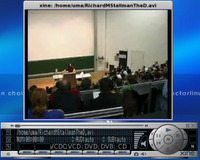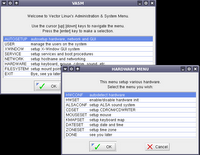Over the years, I have installed and used quite a number of Linux distributions. But one distribution which I hadn't got the chance to install and use was the venerable Slackware. This was because I have encountered some difficulty in downloading this distribution from its official website - They actively encourage downloading the OS using a torrent rather than ftp. Anyway, recently I decided to download a relatively small Linux distribution going by the name Vector Linux. What piqued my interest in downloading this distribution was that it is based on Slackware. The version of Vector Linux I decided to try out was Vector Linux SOHO 5.1 which stands for Small Office Home Office. I downloaded the CD image and burned it into a CD. Then I booted using this CD.
And after a short while, I came face to face with a curses based text based installer. Any body who has installed FreeBSD or Linux distributions like Debian, Slackware or even Ubuntu will feel right at home with this installer. I found it quite intuitive. Here I was faced with making choices. Like I could decide to partition my hard disk using fdisk, resize my existing partition to make space for a new one or just start the installation by selecting the respective menus.
I chose to start the installation as I already had a 3 GB empty partition on my machine. Here the work for me was cut out and I had to make simple choices like decide whether to have the home directory in a separate partition, setup the swap and root mount points, decide which filesystem to use like reiserfs, ext3, ext2 and so on. Next the installer prompted me to choose the integrated packages to install. Here there were no choices to make as the three packages namely base system which contains the kernel, the SOHO base system which contain the software as well as the system configuration package were mandatory.
I chose to start the installation as I already had a 3 GB empty partition on my machine. Here the work for me was cut out and I had to make simple choices like decide whether to have the home directory in a separate partition, setup the swap and root mount points, decide which filesystem to use like reiserfs, ext3, ext2 and so on. Next the installer prompted me to choose the integrated packages to install. Here there were no choices to make as the three packages namely base system which contains the kernel, the SOHO base system which contain the software as well as the system configuration package were mandatory.
The installer then prompted me to choose the optional packages which included drivers for printing, wireless networking drivers, sane scanner back-end, samba and so on. Since I did not have a use for any of these on my machine, I chose not to install these optional packages. After this the actual copying of files to the machine started and I had the option of taking a coffee break or read the names of all the people who contributed to this project scroll through in the upper portion of the screen.
The copying took about 10 minutes on my Pentium IV machine. Once the copying of the files was done, it offered to install the boot loader on my machine. Vector Linux ships with LILO boot loader and one has the option to install the boot loader in a variety of places such as in the master boot record, in a floppy, in the boot sector or decide not to install the boot loader at all. Since I had already installed other OSes and because of my affinity towards Grub, I decided not to install the LILO boot loader.
Next I was faced with the job of configuring the system which includes tasks like setting the time zone, basic hardware auto detection, setting up the network, sound setup, X windows and root password. Optionally one can also set up additional users. But what impressed me the most here was that it offered to probe the legacy ISA sound cards if any on my system. This is the first time that I have found a Linux installer offering to detect any ISA sound cards. All said and done, the installer detected all the interfaces on my machine and I had no problem in booting into Vector Linux.
Vector Linux comes bundled with two stock kernels one optimized for SATA/IDE hard disks and other for SCSI hard disks. And during the installation, one has to choose between the two.
Once the installation is over, one is booted into the KDE 3.4.2 desktop which is the default desktop in Vector Linux. Though it also has the latest version of XFce desktop which is a light weight complete desktop replacement for KDE.
Vector Linux is a well designed Linux distribution with a good collection of software most suited for a small office or home use. What I liked the most about this distribution was that it supported all the multimedia formats out of the box. To test this, I downloaded some video clips and music files in quick time, realplayer, wmv, mpeg and mp3 formats and tried playing each of them by double clicking them. And I was able to play all these formats in Kaffeine which is the default multimedia player in Vector Linux. What is more, it also has the libdvdcss library installed by default which allowed one to play encrypted DVDs.
Vector Linux comes with a choice of media players like Xine, the all powerful Mplayer and Kaffeine to name just a few. I was pleasantly surprised that the developers have integrated the mplayer plugin in Firefox web browser which enabled one to watch video clips inside the browser itself.
In Vector Linux, one has a robust easy to use administration front end in VASM. VASM - the Vector linux's Administration and System Menu - is a graphical front end which aids the user in doing all the system and network administration tasks with ease. VASM can be run in two modes - one the normal user mode where it helps the user in common system administration tasks pertaining to the user like changing his password or making his choice of window manager. And then there is the super user mode which allows one to do all the system administration tasks like managing users; changing the configuration details of the X server; setting up, enabling and disabling services running on the machine; networking and much more. In short, VASM is to Vector Linux what control panel is to Windows.
As this distribution is built on the Slackware base, it brings with it all the positive aspects of Slackware which has ensured it a dedicated fan following. All the packages are in the tar.gz format.And you have the pkgtool which is the equivalent of aptitude in Debian. And it uses slapt-get - an apt-get equivalent for Slackware to download, install and uninstall software. There is also a front-end called Gslapt which has the same functions as Synaptic in Debian based distros. But Vector Linux has made its own improvements too. For example, the Firefox web browser bundled with it is the latest version 1.5 and interestingly, it is free from the memory hog problem faced by it on Ubuntu.
Another aspect which endears me to this secure Linux distribution is its speed.Vector Linux had a couple of extra services like ssh server and inetd server running by default when I installed it on my machine. But I was really impressed by the speed in which it booted to the desktop. It took just 35 seconds from cold start even with the extra services running where as other distributions took a little more than a minute on the same machine with no ssh and inetd services.
The developers of this Linux distribution have taken pains to see that it has all the software needed for running a small to medium business. It comes bundled with OpenOffice.org ver 2.0, Scribus 1.3.1 a desktop publishing software equivalent to Adobe Pagemaker and an accounting package called KMyMoney just to name a few. SAMBA has also been bundled with Vector Linux for people who want to connect to and transfer files to other Windows machines on their LAN. And for printing, you have CUPS - an interface which allows one to feed ones documents to the printer.
Advantages of Vector Linux
Put in a nutshell, these are the advantages a default installation of Vector Linux boasts of when compared to the default installation of main stream Linux distributions like Fedora, Debian and Slackware.
Put in a nutshell, these are the advantages a default installation of Vector Linux boasts of when compared to the default installation of main stream Linux distributions like Fedora, Debian and Slackware.
- Excellent Multimedia support - Plays any video or audio format one throws at it including encrypted DVDs.
- The latest version of Firefox ver 1.5 - And no memory hogging problems too. (Ubuntu developers please note ;) ).
- Sun's Java Runtime Environment ver 1.5 installed by default.
- Flash ver 7.0 plugin for Firefox installed.
- Optimized for speed - Boots up in much lesser time.
- Ideal for a small office setup with the right kind of software bundled with it.
The only drawback I found with Vector Linux was regarding its collection of software in its repository. The software collection for Vector Linux is nowhere near those of Ubuntu and Debian in terms of numbers. But the fact that one can install Slackware packages, somewhat gives relief to this issue. More over I feel the Vector Linux maintainers have taken judicious choices in selecting the software to be included in the repository as well as the base install of the distribution that anyone who is using it in an office setup will find everything they need, available in the repository.
End Note
All things considered, if one is on the lookout for a Linux distribution which is robust, fast, secure, able to play multimedia files without any configuration from the user's side, containing the latest versions of the software and good enough to be used in a small business setup then Vector Linux could fit the bill. Additionally if you are looking for a Slackware based distribution which covers all the above criteria, then Vector Linux is definitely the obvious choice.
All things considered, if one is on the lookout for a Linux distribution which is robust, fast, secure, able to play multimedia files without any configuration from the user's side, containing the latest versions of the software and good enough to be used in a small business setup then Vector Linux could fit the bill. Additionally if you are looking for a Slackware based distribution which covers all the above criteria, then Vector Linux is definitely the obvious choice.





No comments:
Post a Comment